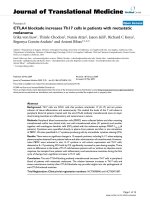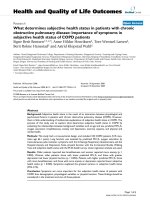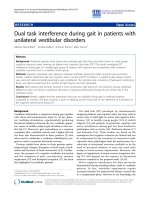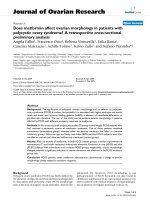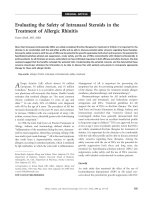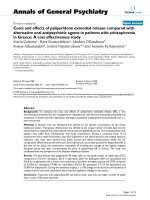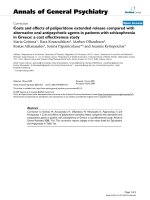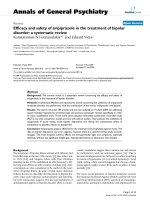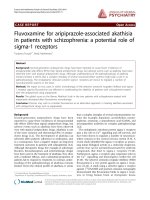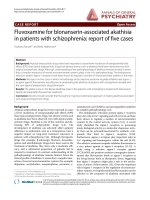Báo cáo y học: "Effectiveness and safety of adalimumab in patients with ankylosing spondylitis or psoriatic arthritis and history of anti-tumor necrosis factor therapy" pdf
Bạn đang xem bản rút gọn của tài liệu. Xem và tải ngay bản đầy đủ của tài liệu tại đây (790.78 KB, 11 trang )
Rudwaleit et al. Arthritis Research & Therapy 2010, 12:R117
/>Open Access
RESEARCH ARTICLE
© 2010 Rudwaleit et al.; licensee BioMed Central Ltd. This is an open access article distributed under the terms of the Creative Commons
Attribution License ( which permits unrestricted use, distribution, and reproduction in
any medium, provided the original work is properly cited.
Research article
Effectiveness and safety of adalimumab in patients
with ankylosing spondylitis or psoriatic arthritis
and history of anti-tumor necrosis factor therapy
Martin Rudwaleit*
1
, Filip Van den Bosch
2
, Martina Kron
3
, Sonja Kary
3
and Hartmut Kupper
3
Abstract
Introduction: Tumor necrosis factor (TNF) antagonists reduce the signs and symptoms of spondyloarthritides,
including ankylosing spondylitis (AS) and psoriatic arthritis (PsA). Our objective was to evaluate the effectiveness and
safety of adalimumab, 40 mg every other week, for patients with AS or PsA and prior treatment with infliximab (IFX)
and/or etanercept (ETN).
Methods: Both trials were 12-week, open-label studies with an optional extension period up to week 20. Patients were
stratified by history of anti-TNF treatment, prior anti-TNF therapy received (IFX, ETN, or both), and reason for
discontinuation of prior TNF antagonist. ETN was discontinued ≥ 3 weeks, and IFX was discontinued ≥ 2 months before
the first adalimumab administration. Effectiveness at week 12 was evaluated by using observed standard-outcome
measurements for AS and PsA.
Results: At week 12 of adalimumab treatment, Bath Ankylosing Spondylitis Disease Activity Index 50 responses were
achieved by 40.8% of 326 patients with AS who had received prior anti-TNF therapy and by 63.0% of 924 patients with
AS who were naive to TNF antagonist. Observed response rates were generally greater for patients who discontinued
the prior anti-TNF therapy because of loss of response or intolerance than for patients who discontinued because of
lack of response. Median changes in swollen-joint count and in enthesitis score were similar in patients with and
without prior TNF-antagonist treatment. Modified PsA response criteria were fulfilled by 71.2% of 66 patients with PsA,
with prior exposure to TNF antagonists, and by 78.8% of 376 patients with no history of anti-TNF therapy. The
percentages of patients with PsA attaining a Physician's Global Assessment of psoriasis of "Clear/Almost clear"
increased from 33.3% to 61.0% for patients with prior IFX and/or ETN treatment and from 34.6% to 69.7% for patients
without anti-TNF therapy. The median change in the Nail Psoriasis Severity Index was -6 for both groups. In both
studies, patterns of adverse events were similar for patients with and without prior anti-TNF therapy and were
consistent with the known safety profile of adalimumab.
Conclusions: Patients with AS or PsA previously treated with IFX and/or ETN experienced clinically relevant
improvements of their diseases after 12 weeks of adalimumab.
Trial registrations: ClinicalTrials.gov NCT00478660 and NCT00235885.
Introduction
Agents that target tumor necrosis factor (TNF) are highly
effective in treating patients with active rheumatic disor-
ders, such as rheumatoid arthritis (RA), ankylosing spon-
dylitis (AS), or psoriatic arthritis (PsA) [1]. Nevertheless,
patients may not respond optimally to or may be intoler-
ant of treatment with a given TNF antagonist. A practical
question faced by clinicians and patients is whether
switching to another TNF antagonist is likely to result in
an improved therapeutic response.
Treatment with a second or third TNF antagonist has
been shown to be successful and well tolerated in a sub-
stantial percentage of patients with RA, regardless of the
order of subsequent therapies (etanercept (ETN), inflix-
* Correspondence:
1
Medical Department I, Rheumatology, Charité, Campus Benjamin Franklin
Hospital, Hindenburgdamm 30, 12200 Berlin, Germany
Full list of author information is available at the end of the article
Rudwaleit et al. Arthritis Research & Therapy 2010, 12:R117
/>Page 2 of 11
imab (IFX), or adalimumab) [2-6]. In RA, a patient's fail-
ure to respond to one TNF antagonist does not predict
failure with a second anti-TNF agent [6-9], and it is rare
for a patient to fail to respond to three [10]. However,
analyses of switching to another TNF antagonist for
patients with spondyloarthritides, such as AS or PsA, are
quite limited and often represent a minor subgroup of
patients with various rheumatic diseases evaluated in
national registries [2,3,11-16].
Adalimumab, a fully human monoclonal antibody that
binds to and neutralizes TNF, is approved for the treat-
ment of AS, PsA, RA, psoriasis, juvenile idiopathic arthri-
tis, and Crohn disease in Europe, Canada, the United
States, and other world regions [17]. In two open-label
clinical studies, we investigated the effectiveness and
safety of adalimumab in treating patients with active AS
or PsA who had a history of therapy with IFX or ETN or
both: Review of Safety and Effectiveness witH Adali-
mumab in Patients with Active Ankylosing SpOnDYlitis
(RHAPSODY) and SafeTy and Efficacy of Adalimumab in
Patients with Active Psoriatic Arthritis (PsA): An Open-
Label, Multinational Study to Evaluate the Response to
Every-Other-Week Adalimumab When Added to Insuffi-
cient Standard Therapy including Patients Who Failed
Prior Treatment With Other TNF-Inhibitors (STEREO)
[18,19]. These analyses included stratification by prior
anti-TNF treatment received (IFX, ETN, or both) and by
the reason for discontinuation of the prior anti-TNF ther-
apy.
Materials and methods
Patients
Adults at least 18 years of age with AS according to the
1984 modified New York criteria for AS [20] for at least 3
months and a Bath Ankylosing Spondylitis Disease Activ-
ity Index (BASDAI) [21] score ≥ 4 and failure of ≥ 1 non-
steroidal antiinflammatory drugs (NSAIDs) were eligible
to enroll in RHAPSODY [18]. The STEREO study
enrolled adults at least 18 years of age with PsA diag-
nosed by a rheumatologist, three or more swollen and
three or more tender joints, and failure of one or more
disease-modifying antirheumatic drugs (DMARDs) [19].
Prior treatment with ETN and with IFX was allowed in
both studies if ETN was discontinued ≥ 3 weeks and IFX
was discontinued ≥ 2 months before the first adalimumab
injection [18,19].
Study design and measures
The RHAPSODY and STEREO studies were conducted
in accordance with the principles of the Declaration of
Helsinki, and the protocols were approved by the institu-
tional review boards of the participating centers. All
patients provided written informed consent before any
study-related procedures were initiated [18,19].
In both studies, patients subcutaneously self-adminis-
tered adalimumab, 40 mg (Abbott Laboratories, Abbott
Park, IL) every other week in addition to their preexisting
antirheumatic treatments for a core study period of 12
weeks, with an optional extension period up to week 20.
For patients who had prior exposure to TNF antagonists,
study investigators documented the reasons for discon-
tinuation of IFX and/or ETN in four prespecified catego-
ries: never achieved response (lack of response), loss of
initial response (loss of response), adverse effects (intol-
erance), and other. Answers were not mutually exclusive.
Evaluations of effectiveness and safety were conducted at
weeks 2, 6, 12, and 20, as applicable.
Measures of effectiveness of adalimumab for patients
with AS included ≥ 40% improvement in the Assessment
of SpondyloArthritis International Society criteria
(ASAS40) [22], ≥ 50% improvement in the BASDAI
(BASDAI 50) [23], and changes in BASDAI and the Bath
Ankylosing Spondylitis Functional Index (BASFI) [24], as
measured on a 0 to 10 cm horizontal visual analogue
scale (VAS). Changes in swollen-joint count (SJC, 0 to 44)
and tender joint count (TJC, 0 to 46) were calculated for
patients with at least one swollen peripheral joint at base-
line. Change in Maastricht Ankylosing Spondylitis
Enthesitis Score (MASES, 0 to 13) [25] was evaluated for
patients with enthesitis (one or more inflamed enthesis
assessed by MASES) at baseline. Serum concentrations of
CRP (milligrams per deciliter) are shown only for base-
line.
Effectiveness measures for patients with PsA included
the modified Psoriatic Arthritis Response Criteria
(mPsARC) [26]; ≥ 50% improvement in the American
College of Rheumatology response criteria (ACR50) [27];
TJC (0 to 78 joints), SJC (0 to 76 joints), and changes in
TJC and SJC; and the Health Assessment Questionnaire
Disability Index (HAQ DI, 0 to 3) [28]. Psoriasis severity
was assessed by using the Physician's Global Assessment
(PGA) 7-point scale with end points of "Clear " and
"Severe" [29]. Psoriatic nail dystrophy was evaluated by
using the Nail Psoriasis Severity Index (NAPSI [0 to 80],
fingernails only) in patients with a NAPSI score ≥ 1 at
baseline [30].
In both trials, adverse events (AEs) were collected
throughout the treatment of each patient and for 70 days
(five serum half-lives) after the last adalimumab injection.
Statistical analyses
All patients who received at least one adalimumab injec-
tion were included in the analyses. Observed data at week
12 were used for all analyses of effectiveness. Patients in
both studies were stratified into two major subgroups: no
prior TNF antagonist and one or more prior TNF antago-
nists (prior IFX or ETN or both). Patients with a history
of anti-TNF treatment were also stratified based on
Rudwaleit et al. Arthritis Research & Therapy 2010, 12:R117
/>Page 3 of 11
whether they had been treated with IFX, ETN, or both,
and according to whether the reason for discontinuation
of the prior TNF antagonist had been lack of response,
loss of response, or intolerance. Analyses pertaining to
the reason for discontinuation included only those
patients who had stopped their prior anti-TNF therapy
exclusively for one of these reasons. Thus, patients with
more than one reason for prior discontinuation were
excluded from analysis, unless the only additional reason
was "other."
Descriptive analyses were performed by calculating
counts and percentages for qualitative data and by calcu-
lating means, standard deviations, medians, and first and
third quartiles (for strata with n < 50, minimum-maxi-
mum) for quantitative data. Based on previous evalua-
tions of predictors of response, the following continuous
variables were considered possible confounders: age (per
year), disease duration (per year), BASDAI (AS) or TJC
(PsA), SJC (PsA), CRP, and BASFI (AS) or HAQ DI (PsA)
[18,19]. Categoric variables (yes versus no) evaluated as
possible confounders included male sex, HLA-B27 (AS),
SJC >0 (AS), enthesitis (AS), PGA < "Clear" (PsA), NAPSI
>0 (PsA), and ongoing treatment with NSAIDs (AS) or
DMARDs (PsA) [18,19]. Comparisons of the end points
ASAS 40 and BASDAI 50 in subsets of patients with AS
defined by prior IFX or ETN therapy or both (yes versus
no), by prior anti-TNF therapy used (IFX, ETN, or both),
and by reason for discontinuation of prior TNF antago-
nist (lack of response, loss of response, or intolerance)
were performed by using logistic regression unadjusted
and adjusted for baseline differences in possible con-
founders. ACR50 and mPsARC outcomes were compared
unadjusted and adjusted in subsets of patients with PsA
defined by prior IFX or ETN therapy or both (yes versus
no).
Results
Prior anti-TNF therapy
In total, 1,250 patients with AS were enrolled in the
RHAPSODY study. Of these, 924 had no history of anti-
TNF therapy, and 326 (26%) patients had been treated
with at least one TNF antagonist (162 patients with IFX,
85 patients with ETN, and 79 patients with both IFX and
ETN [not concurrently] (Table 1), including 18 patients
with IFX as the last TNF antagonist). In total, 442
patients with PsA were enrolled in the STEREO study. Of
these, 376 had received no prior anti-TNF therapy, and 66
(15%) patients had been treated with at least one TNF
antagonist (18 patients with IFX, 34 patients with ETN,
and 14 patients with both IFX and ETN (not concur-
rently) (Table 2), including one patient with IFX as the
last TNF antagonist). The mean/median duration of prior
anti-TNF therapy was 18/15 months for patients with AS,
and 20/16 months for patients with PsA. The mean/
median time from the last dose of the last TNF antagonist
to the first injection of adalimumab was 6.3/2.7 months
for patients with AS and 6.1/2.0 months for patients with
PsA. The reason for discontinuation of the prior TNF
antagonist was lack of response for 64 patients with AS
and 14 patients with PsA, loss of response for 115
patients with AS and 29 patients with PsA, and intoler-
ance for 56 patients with AS and nine patients with PsA
(Tables 1 and 2).
Patient disposition and exposure to adalimumab
Overall, 97% of 1,250 patients with AS completed the 12-
week treatment with adalimumab. During the complete
study, 1% of patients with AS (10 of 924) without prior
anti-TNF therapy and 3% of patients with AS (11 of 326)
with prior anti-TNF therapy withdrew because of an
unsatisfactory response to adalimumab. Forty-four (5%)
of patients without prior anti-TNF therapy and 22 (7%) of
patients with previous anti-TNF therapy discontinued
adalimumab because of AEs.
In the PsA study, 94% of 442 enrolled patients contin-
ued adalimumab therapy through week 12. During the
study, 1% of TNF antagonist-naïve patients with PsA (five
of 376) and 2% of patients with PsA previously treated
with TNF antagonists (one of 66) discontinued adali-
mumab because of an unsatisfactory response. Six per-
cent of patients (24 of 376) without prior anti-TNF
therapy and 3% of patients (two of 66) with prior anti-
TNF therapy withdrew from the study because of AEs.
For both studies, the mean/median treatment period
with adalimumab was 15/12 weeks for all patients
enrolled.
Baseline demographics and disease characteristics
In both studies, demographics and the distribution of
clinical manifestations were comparable between patients
with and without prior anti-TNF therapy (Tables 1 and 2).
Patients with AS and a history of anti-TNF therapy had
slightly greater disease activity and more physical-func-
tion disability than did TNF antagonist-naïve patients
(Table 3). Patients with PsA with and without histories of
anti-TNF therapy had similar median TJCs and SJCs at
baseline, whereas the functional impairment measured
by the HAQ DI was greater for patients with a history of
anti-TNF therapy than for anti-TNF agent-naïve patients
(Table 4).
Effectiveness
Patients with AS stratified by history of anti-TNF therapy
At week 12, disease activity and physical impairment
were notably reduced for all patient groups, as indicated
by BASDAI and BASFI; the changes were generally great-
est for patients naïve to anti-TNF agents (Table 3).
ASAS40 response rates were 59.3% for patients without
prior TNF-antagonist treatment and 37.7% for patients
Rudwaleit et al. Arthritis Research & Therapy 2010, 12:R117
/>Page 4 of 11
with a history of anti-TNF therapy. BASDAI 50 responses
were achieved by 63.0% of patients with AS without prior
anti-TNF therapy and by 40.8% of patients with AS who
had received prior anti-TNF therapy. Logistic regression
showed that patients with prior anti-TNF therapy had a
smaller likelihood of achieving an ASAS40 or BASDAI 50
response (Table 5).
ASAS40 and BASDAI 50 responses were greatest for
the 162 patients with AS with only prior IFX therapy
compared with patients with only prior ETN therapy and
those with prior treatment with both IFX and ETN. In the
logistic regression, the odds of achieving an ASAS40
response were not statistically different (P = 0.083) for
patients with only prior IFX therapy or only ETN therapy,
compared with the reference group of patients who had
received both IFX and ETN (Table 5). In contrast, the
odds of achieving a BASDAI 50 response were signifi-
cantly greater for patients who had received only IFX (P =
0.033) (Table 5).
The observed ASAS40 and BASDAI 50 response rates
at week 12 for patients stratified by reason for discontinu-
ation of the prior TNF antagonist were greater for
patients with loss of response or intolerance than for
patients who had lack of response to the prior TNF antag-
onist (Table 5). However, unadjusted comparisons by
logistic regression revealed that the probability of achiev-
ing ASAS 40 or BASDAI 50 responses was not statisti-
cally different for patients who discontinued prior anti-
TNF therapy because of loss of response or intolerance
compared with patients who experienced lack of
response (Table 5). None of the results of the logistic
regression analyses was relevantly changed after further
adjustment for the baseline confounders listed previously.
Stratification first by exclusive treatment with IFX and
then by reason for discontinuation resulted in observed
BASDAI 50 response rates at week 12 of 48.5% for loss of
response (n = 66), 52.6% for intolerance (n = 38), and
22.7% for lack of response (n = 22). For patients who had
been treated only with ETN, the BASDAI 50 response
rates at week 12 were 33.3% for loss of response (n = 33),
33.3% for intolerance (n = 12), and 32% for lack of
response (n = 12). The pattern for ASAS40 response rates
was overall similar for patients with previous ETN ther-
apy. The ASAS40 response rates in patients who discon-
tinued IFX stratified by reason for discontinuation
showed smaller differences than the BASDAI 50 response
rates: 50.8% for loss of response, 38.9% for intolerance,
and 27.3% for lack of response.
At week 12 of the study, patients with AS with periph-
eral arthritis or with enthesitis at baseline and previous
treatment with TNF antagonists experienced quite simi-
lar improvements in joint counts and in MASES, as did
patients without a history of anti-TNF therapy (Table 3).
Table 1: Baseline demographic and disease characteristics of patients with AS stratified by prior anti-TNF therapy
Patients with AS (N = 1,250)
Prior TNF antagonist(s) Reason for discontinuation of prior
TNF antagonist
a
No prior
ETN/IFX
Prior ETN
and/or IFX
IFX only ETN only IFX and ETN Lack of
response
Loss of
response
Intolerance
Characteristic (n = 924) (n = 326) (n = 162) (n = 85) (n = 79) (n = 64) (n = 115) (n = 56)
Male (%) 7172 785972 7566 68
Age (years; mean ± SD) 44 ± 12 44 ± 11 44 ± 10 44 ± 12 43 ± 10 45 ± 10 42 ± 10 44 ± 13
AS duration (years; mean ± SD) 11 ± 10 11 ± 9 12 ± 9 9 ± 9 11 ± 8 10 ± 9 11 ± 8 12 ± 10
HLA-B27 positive (%) 8381 808281 8682 84
Peripheral arthritis (%)
b
22 25 26 27 19 23 24 34
Enthesitis (%)
c
55 55 52 57 60 50 56 64
Concomitant NSAIDs (%)7766 695771 5368 66
C-reactive protein (mg/dl)
d
1.3 1.2 1.4 1.1 1.1 1.4 1.6 0.8
0.6, 2.6 0.5, 2.6 0.5, 3.0 0.4, 2.2 0.4, 2.6 0.7, 2.8 0.6, 2.7 0.3, 1.7
a
No additional reason except for "other."
b
One or more swollen joint count (0 to 44).
c
One or more inflamed enthesis in Maastricht Ankylosing
Spondylitis Enthesitis Score or fascia plantaris or both.
d
Reference value, 0.4 mg/dl; values listed are median and quartile 1, quartile 3 because of
skewed distribution. AS, ankylosing spondylitis; ETN, etanercept; IFX, infliximab; NSAIDs, nonsteroidal antiinflammatory drugs; TNF, tumor
necrosis factor.
Rudwaleit et al. Arthritis Research & Therapy 2010, 12:R117
/>Page 5 of 11
Patients with PsA stratified by history of anti-TNF therapy
The median changes in TJC, SJC, and HAQ DI were very
similar for patients without and with previous TNF-
antagonist treatment (Table 4). At week 12, the percent-
ages of patients who achieved ACR50 and mPsARC
responses were somewhat greater for those without a his-
tory of anti-TNF therapy than for those with prior anti-
TNF therapy (ACR50: 52.3% versus 41.7%; mPsARC:
78.8% versus 71.2%). Unadjusted logistic regression
revealed that the likelihood of attaining an ACR50
response or mPsARC response did not considerably differ
between patients without and those with prior anti-TNF
therapy (Table 6). The results remained unchanged after
adjustment for other confounders at baseline.
At week 12, ACR50 and mPsARC responses were
achieved by 10 and 13, respectively, of 18 patients with
prior IFX therapy; by 11 and 18 of 30 patients with prior
ETN therapy; and by four and 11 of 13 patients previously
treated with both IFX and ETN (observed data). ACR50
and mPsARC responses were achieved by five and seven,
respectively, of 13 patients with PsA with lack of response
to prior TNF-antagonist treatment; by 10 and 17 of 27
patients with loss of response; and by five and seven of
eight patients who were intolerant of prior anti-TNF
therapy (observed data).
Patients achieving a PGA of "Clear/Almost clear"
increased by 35.1 percentage points between baseline and
week 12 for patients without prior TNF-antagonist treat-
ment and by 27.7 percentage points for patients with a
history of anti-TNF therapy (Figure 1). For patients with
psoriatic nail dystrophy at baseline, the median change in
NAPSI was similar in patients without and in patients
with prior treatment with IFX and/or ETN (Table 4).
Safety
The rates of serious adverse events (SAEs) were 3.1% and
4.3% for patients with AS without and with prior TNF-
antagonist treatment, respectively. The rates of serious
infections were 0.4% in patients with no prior exposure to
TNF antagonists and 0.3% in patients who had received
prior TNF-antagonist therapy. No serious allergic reac-
tion was reported in the AS study.
For patients with PsA, the rates of SAEs were 4.3% and
3.0% in patients without and with prior TNF-antagonist
therapy, respectively. Serious infections were docu-
mented for 0.5% of patients without prior anti-TNF ther-
apy and for one patient (1.5%) with prior anti-TNF
therapy. One TNF antagonist-naïve patient experienced a
serious allergic reaction, which was the only one reported
in the STEREO study. No cases of lupus, lupus-like reac-
Table 2: Baseline demographic and disease characteristics of patients with PsA stratified by prior anti-TNF therapy
Patients with PsA (N = 442)
Prior TNF antagonist(s) Reason for discontinuation of prior
TNF antagonist
a
No prior
ETN/IFX
Prior ETN
and/or IFX
IFX only ETN only IFX and ETN Lack of
response
Loss of
response
Intolerance
Characteristic (n = 376) (n = 66) (n = 18) (n = 34) (n = 14) (n = 14) (n = 29) (n = 9)
Male (%) 50 47 61 41 43 50 45 44
Age (years; mean ± SD) 48 ± 11 47 ± 12 44 ± 12 47 ± 13 50 ± 8 43 ± 10 48 ± 13 51 ± 11
PsA duration (years; mean ± SD) 10 ± 8 12 ± 8 13 ± 7 9 ± 8 17 ± 8 7 ± 5 14 ± 7 14 ± 11
Psoriasis (%)
b
83 80 78 79 86 79 79 78
Nail dystrophy (%)
c
59 55 72 41 64 43 62 11
Concomitant DMARDs (%) 71 52 72 35 64 29 59 44
Concomitant glucocorticoids (%) 26 44 44 41 50 36 41 44
C-reactive protein (mg/dl)
d
0.9 1.3 0.8 1.5 1.1 0.8 1.6 1.4
0.4, 2.2 0.3, 2.8
0.1 to 8.4
e
0.1 to 7.0
e
0.5 to 4.7
e
0.1 to 7.0
e
0.1 to 8.4
e
0.2 to 3.4
e
a
No additional reason except for "other."
b
Patients with PGA other than "Clear."
c
Patients with NAPSI score ≥ 1.
d
Reference value, 0.4 mg/dl; values
listed are median and quartile 1, quartile 3 because of skewed distribution.
e
Ranges presented are minimum to maximum because of small
numbers of patients per group. DMARDs, disease-modifying antirheumatic drug; ETN, etanercept; IFX, infliximab; NAPSI, nail psoriasis severity
index; NSAID, nonsteroidal antiinflammatory drug; PGA, Physician's Global Assessment of psoriasis; PsA, psoriatic arthritis; TNF, tumor necrosis
factor.
Rudwaleit et al. Arthritis Research & Therapy 2010, 12:R117
/>Page 6 of 11
tion, or malignancies of any type were observed in either
of the two studies.
Discussion
This study represents the first evaluation of the effective-
ness of adalimumab in patients with spondyloarthritis
(AS and PsA) who had previously been treated with one
or two other TNF antagonists. The disease characteristics
of the patients in both studies closely matched those of
patients considered eligible for anti-TNF therapy in daily
practice [31,32].
After 12 weeks of adalimumab therapy, patients with
AS or PsA having prior exposure to IFX or ETN or both
experienced clinically important improvements of their
diseases, as evaluated by standard outcome measures.
However, response rates were generally lesser than those
for patients who had not received prior anti-TNF therapy.
Unadjusted and adjusted logistic regressions indicated
that the likelihood of achieving BASDAI 50 and ASAS40
responses after 12 weeks was smaller for patients with
than for those without a history of anti-TNF therapy. For
patients with PsA, prior anti-TNF therapy also resulted in
a lesser likelihood to achieve ACR50 (odds ratio, 0.65)
and mPsARC (odds ratio, 0.66) responses, but this impact
was not statistically important (ACR50 response rate, P =
0.130; mPsARC response rate, P = 0.194) (Table 6). In the
Table 3: Effectiveness of 12-week adalimumab treatment in patients with AS stratified by prior anti-TNF therapy
Outcome measure No prior ETN/IFX Prior ETN and/or IFX
(n = 924) (n = 326)
BASDAI (0 to 10)
Baseline 6.2 6.5
5.2, 7.2 5.5, 7.6
Change, Baseline to week 12 -3.7 -2.5
-5.1, -1.9 -4.2, -1.0
BASFI (0 to 10)
Baseline 5.2 6.0
3.5, 7.0 4.3, 7.5
Change, Baseline to week 12 -2.2 -1.3
-3.9, -0.8 -2.8, -0.1
Patients with peripheral arthritis (SJC ≥ 1) n = 201 n = 80
TJC (0 to 46)
Baseline 4 6
2, 11 3, 14
Change, Baseline to week 12 -3 -3
-8, -1 -8, -1
SJC (0 to 44)
Baseline 2 2
1, 4 1, 4
Change, Baseline to week 12 -2 -1
-4, -1 -2, -1
Patients with enthesitis (MASES ≥ 1) n = 492 n = 175
MASES (0 to 13)
Baseline 5 5
2, 8 3, 9
Change, Baseline to week 12 -3 -2
-5, -1 -5 , -1
Values are expressed as median and quartile 1, quartile 3. AS, ankylosing spondylitis; BASDAI, Bath Ankylosing Spondylitis Disease Activity
Index; BASFI, Bath Ankylosing Spondylitis Functional Index; ETN, etanercept; IFX, infliximab; MASES, Maastricht Ankylosing Spondylitis
Enthesitis Score; TJC, tender joint count; TNF, tumor necrosis factor; SJC, swollen joint count.
Rudwaleit et al. Arthritis Research & Therapy 2010, 12:R117
/>Page 7 of 11
PsA study, the impact of other confounders (sex, HAQ
DI, joint counts, and PsA duration) was greater than that
of prior anti-TNF therapy. Fewer patients were in the PsA
study than in the AS study; therefore, the likelihood of
detecting statistically important differences was less. The
studies were not powered to detect differences between
subgroups. However, assuming a response rate of 50% in
one subgroup, an odds ratio of 1.5, and sample sizes of
900 versus 300 in the subgroups, the χ
2
test would have
>95% power to detect a difference in the response rates.
The power would be 63% with sample sizes of 150 versus
80 and 61% with sample sizes of 350 versus 60.
Overall, the ASAS40 and BASDAI 50 response rates for
patients with AS and a history of anti-TNF therapy were
clinically meaningful (Table 5). Notably, adalimumab
therapy reduced peripheral arthritis and enthesitis; the
effectiveness of adalimumab for these extraaxial manifes-
tations was very similar for patients with and without
prior TNF-antagonist treatment (Table 3).
The ASAS40 and BASDAI 50 response rates were
greater in patients who had been treated only with IFX
therapy than in patients with only ETN therapy. However,
the probability of achieving an ASAS40 response did not
remarkably differ between patients with histories of treat-
ment with IFX, ETN, or both. The likelihood of achieving
a BASDAI 50 response was significantly greater for
patients with prior IFX therapy.
Logistic regression analyses demonstrated that the rea-
son for discontinuation of the prior TNF antagonist had
no statistically important impact on the chances of expe-
riencing ASAS40 or BASDAI 50 responses. However, the
observed ASAS40 and BASDAI 50 response rates were
greater for patients who discontinued prior anti-TNF
therapy because of loss of response or intolerance than
they were for those patients who discontinued the first
anti-TNF agent because of lack of response. Stratifica-
tions first by type of prior TNF antagonist and then by
reason for discontinuation showed similar response rates
to adalimumab in patients who had lack of response to
Table 4: Effectiveness of 12-week adalimumab treatment in patients with PsA stratified by prior anti-TNF therapy
Outcome measure No prior ETN/IFX Prior ETN or IFX or both
(n = 376) (n = 66)
TJC (0 to 78)
Baseline 16 15
10, 27 8, 25
Change, Baseline to week 12 -10 -10
-17, -5 -16, -3
SJC (0 to 76)
Baseline 9 7
5, 13 5, 11
Change, Baseline to week 12 -7 -5
-10, -3 -8, -3
HAQ DI (0 to 3)
Baseline 1.25 1.44
0.75, 1.63 1.00, 1.75
Change, Baseline to week 12 -0.50 -0.50
-0.88, -0.13 -0.75, -0.25
Patients with nail psoriasis (NAPSI ≥ 1) n = 223 n = 36
NAPSI (0 to 80)
Baseline 14 18
5, 30 10, 37
Change, Baseline to week 12 -6 -6
-14, -2 -15, -1
Values are expressed as median and quartile 1, quartile 3. ETN, etanercept; HAQ DI, Health Assessment Questionnaire Disability Index; IFX,
infliximab; NAPSI, Nail Psoriasis Severity Index (only fingernails); PsA, psoriatic arthritis; SJC, swollen joint count; TJC, tender joint count; TNF,
tumor necrosis factor.
Rudwaleit et al. Arthritis Research & Therapy 2010, 12:R117
/>Page 8 of 11
the preceding TNF antagonist. Patients who had initially
responded to prior IFX and discontinued IFX because of
loss of response (perhaps caused by antibodies against
IFX) or because of intolerance experienced much greater
BASDAI 50 and ASAS40 response rates than did patients
who discontinued IFX after lack of initial response. In
patients who had been treated with only ETN, stratifica-
tion by reason for discontinuation showed overall similar
response rates across the subsets. The interpretation of
this result is limited by the small numbers of patients who
had been treated only with ETN. Thus, patients who ini-
tially respond to a first TNF antagonist may be more
likely also to respond to a second TNF antagonist, in par-
ticular when the type of agent is similar (monoclonal
antibody). These results are generally consistent with pre-
vious analyses of patients with RA treated with adali-
mumab as the second or third TNF antagonist in the
ReAct trial (Research in Active Rheumatoid Arthritis
Trial) [5]. ReAct, STEREO, and RHAPSODY were all
designed to follow routine clinical practice for patient
enrollment.
Patients with PsA who had prior IFX or ETN therapy or
both achieved clinically meaningful ACR50 and mPsARC
response rates of 41.7%, and 71.2%, respectively. The his-
tory of anti-TNF therapy had no relevant impact on the
likelihood of achieving an ACR50 response in the unad-
justed evaluations (as mentioned earlier, the adjustment
for confounders did not change this result). Patients with
Table 5: ASAS40 and BASDAI 50 response rates at week 12 in patients with AS stratified by prior anti-TNF therapy
ASAS40 BASDAI 50
Response rate,
n/N (%)
Unadjusted odds
ratio
P value Response rate,
n/N (%)
Unadjusted odds
ratio
P value
(95% CI) (95% CI)
History of prior anti-TNF therapy
Prior ETN or IFX or both 115/305 (37.7) 0.41 (0.32 to 0.54) < 0.001 128/314 (40.8) 0.40 (0.31 to 0.53) < 0.001
No prior ETN/IFX
a
518/873 (59.3) 561/890 (63.0)
Prior TNF antagonist(s)
ETN only 25/81 (30.9) 0.93 (0.47 to 1.83) 0.083 27/81 (33.3) 0.98 (0.51 to 1.90) 0.033
IFX only 66/150 (44.0) 1.64 (0.91 to 2.93) 75/156 (48.1) 1.82 (1.03 to 3.20)
ETN and IFX
a
24/74 (32.4) 26/77 (33.8)
Reason for discontinuation of
prior TNF antagonist
Loss of response 46/108 (42.6) 2.09 (1.05 to 4.14) 0.108 47/112 (42.0) 2.03 (1.03 to 4.03) 0.059
Intolerance 20/52 (38.5) 1.76 (0.79 to 3.91) 25/54 (46.3) 2.42 (1.11 to 5.30)
Lack of response
a
16/61 (26.2) 16/61 (26.2)
a
Used as reference value. AS, ankylosing spondylitis; ASAS40, Assessment of SpondyloArthritis international Society 40% response; BASDAI 50,
Bath AS Disease Activity Index 50% response; CI, confidence interval; ETA, etanercept; IFX, infliximab; TNF, tumor necrosis factor.
Table 6: ACR50 and mPsARC response rates at week 12 in patients with PsA stratified by prior anti-TNF therapy
ACR50 mPsARC
Response rate, Unadjusted odds ratio P value Response rate, Unadjusted odds ratio P value
n/N (%) (95% CI) n/N (%) (95% CI)
History of prior anti-TNF
therapy
Prior ETN or IFX or both 25/60 (41.7) 0.65 (0.37 to 1.13) 0.130 42/59 (71.2) 0.66 (0.36 to 1.23) 0.194
No prior ETN/IFX
a
182/348 (52.3) 272/345 (78.8)
a
Used as reference value. ACR50, American College of Rheumatology 50% or more improvement; CI, confidence interval; ETN, etanercept; IFX,
infliximab; mPsARC, modified Psoriatic Arthritis Response Criteria; PsA, psoriatic arthritis.
Rudwaleit et al. Arthritis Research & Therapy 2010, 12:R117
/>Page 9 of 11
PsA who had lack of response to prior TNF-antagonist
therapy experienced somewhat less clinical improvement
with adalimumab compared with patients with loss of
response or intolerance to their prior TNF-antagonist
treatment. Adalimumab was similarly effective for
patients with prior IFX or ETN therapy. However, no
logistic regression was performed owing to small group
sizes. Adalimumab was also highly effective for psoriatic
skin and nail lesions for patients with a history of anti-
TNF therapy, with improvements similar to those of
patients with PsA who were naive to TNF antagonists.
A limitation of these evaluations is the open-label study
design and the explorative nature of the investigations.
The response rates in patients without prior anti-TNF
therapy were generally greater than the rates reported in
randomized clinical trials of adalimumab [33,34], ETN
[35,36], and IFX [37,38] in AS or in PsA, in which prior
treatment with other TNF antagonists was generally pro-
hibited. For example, the ASAS40 response at week 12
was 59.3% in patients with AS without prior anti-TNF
therapy in this open-label study and 39.9% in the adali-
mumab ATLAS trial [33]. In patients with PsA, the
ACR50 response rate was 52.3% for patients without
prior anti-TNF therapy in this open-label study and 36%
in the adalimumab ADEPT trial [34]. A potential expla-
nation for the greater response rates in our open-label,
explorative studies is that the evaluations were based on
observed data and omission of missing data, whereas
patients with missing data were imputed to be nonre-
sponders in the intention-to-treat analyses of random-
ized trial data. Furthermore, patients (and physicians)
may somewhat overestimate the treatment effect in
open-label studies, particularly when no alternative treat-
ment is available, as is often the case for patients with AS.
Conclusions
Patients with AS and patients with PsA previously treated
with TNF antagonists experienced clinically important
improvements in their diseases after 12 weeks of adali-
mumab therapy during these two large, open-label clini-
cal studies. The safety profile of adalimumab was similar
in patients with and without prior anti-TNF therapy and
consistent with results from other adalimumab clinical
trials.
Abbreviations
ACR: American College of Rheumatology; AS: ankylosing spondylitis; ASAS:
Assessment of SpondyloArthritis International Society; BASDAI: Bath Ankylos-
ing Spondylitis Disease Activity Index; BASFI: Bath Ankylosing Spondylitis Func-
tional Index; CRP: C-reactive protein; DMARDs: disease modifying
antirheumatic drugs; ETN: etanercept; HAQ DI: Health Assessment Question-
naire Disability Index; IFX: infliximab; MASES: Maastricht Ankylosing Spondylitis
Enthesitis Score; mPsARC: modified Psoriatic Arthritis Response Criteria; NAPSI:
Nail Psoriasis Severity Index; NSAIDs: nonsteroidal antiinflammatory drugs;
PGA: Physician's Global Assessment; PsA: psoriatic arthritis; RA: rheumatoid
arthritis; SJC: swollen joint count; TJC: tender joint count; TNF: tumor necrosis
factor; VAS: visual analogue scale.
Competing interests
MR has served as a consultant and has received speaking fees and honoraria
from Abbott, MSD, Schering-Plough, Pfizer, and Wyeth. FVdB has received
speakers bureau honoraria and/or has served as a consultant for Abbott Labo-
ratories, Schering-Plough, UCB, and Wyeth. MK and HK are full-time employees
of Abbott GmbH & Co. KG, an affiliate of Abbott Laboratories and hold shares of
Abbott stock. SK is a contractor of Abbott GmbH & Co. KG.
Authors' contributions
MK and HK (with other academic experts and members of Abbott Laborato-
ries) designed the RHAPSODY and STEREO clinical trials. MR was the principal
investigator for the RHAPSODY study. FVdB was the principal investigator for
the STEREO study. MK designed and performed the statistical analyses. SK
drafted the manuscript in cooperation with the principal investigators and
coauthors. All authors reviewed and approved the final content of the submit-
ted manuscript.
Acknowledgements
We thank the following Abbott Laboratories contributors: Angelika Freitag,
Anja Bruhn, and Vera Rattemeyer-Matschurat for programming, and Ria Reis-
chmann and Christa Zaiti-Runkel for database management. Teresa R. Brtva,
PhD, of Arbor Communications, Inc., and Michael A. Nissen, ELS, of Abbott Lab-
oratories provided medical writing and editing support on behalf of the
authors. This work was funded by Abbott Laboratories, Abbott Park, IL, USA.
Author Details
1
Medical Department I, Rheumatology, Charité, Campus Benjamin Franklin
Hospital, Hindenburgdamm 30, 12200 Berlin, Germany,
2
Department of
Rheumatology, University Hospital Gent, De Pintelaan 185, B-9000 Gent,
Belgium and
3
Abbott GmbH & Co. KG, Knollstrasse 50, Ludwigshafen, 67061,
Germany
References
1. Furst DE, Keystone EC, Fleischmann R, Mease P, Breedveld FC, Smolen JS,
Kalden JR, Braun J, Bresnihan B, Burmester GR, De Benedetti F, Dörner T,
Emery P, Gibofsky A, Kavanaugh A, Kirkham B, Schiff MH, Sieper J, Singer
N, Van Riel PL, Weinblatt ME, Weisman MH, Winthrop K: Updated
consensus statement on biological agents for the treatment of
rheumatic diseases, 2009. Ann Rheum Dis 2008, 69 Suppl 1:i2-i29.
Received: 15 January 2010 Revised: 21 May 2010
Accepted: 16 June 2010 Published: 16 June 2010
This article is available from: 2010 Rudwaleit et al.; licensee BioMed Central Ltd. This is an open access article distributed under the terms of the Creative Commons A ttribution License ( which permits unrestricted use, distribution, and reproduction in any medium, provided the original work is properly cited.Arthritis R esearch & Thera py 2010, 12:R117
Figure 1 Percentages of patients with psoriatic arthritis achiev-
ing a Physician's Global Assessment (PGA) of "Clear/Almost clear"
at baseline and week 12, stratified by history of anti-tumor necro-
sis factor therapy. Data are observed. IFX, infliximab; ETN, etanercept.
34.6
33.3
69.7
61.0
0
20
40
60
80
100
No Prior IFX/ETN Prior IFX/ETN
Patients with PGA "Clear/Almost Clear" (%)
Baseline Week 12
N = 66N = 376
Rudwaleit et al. Arthritis Research & Therapy 2010, 12:R117
/>Page 10 of 11
2. Gomez-Reino JJ, Carmona L, BIOBADASER Group: Switching TNF
antagonists in patients with chronic arthritis: an observational study of
488 patients over a four-year period. Arthritis Res Ther 2006, 8:R29.
3. Conti F, Ceccarelli F, Marocchi E, Magrini L, Spinelli FR, Spadaro A, Scrivo R,
Valesini G: Switching tumour necrosis factor alpha antagonists in
patients with ankylosing spondylitis and psoriatic arthritis: an
observational study over a 5-year period. Ann Rheum Dis 2007,
66:1393-1397.
4. Hyrich KL, Lunt M, Watson KD, Symmons DP, Silman AJ: Outcomes after
switching from one anti-tumor necrosis factor α agent in patients with
rheumatoid arthritis. Arthritis Rheum 2007, 56:13-20.
5. Bombardieri S, Ruiz AA, Fardellone P, Geusens P, McKenna F, Unnebrink K,
Oezer U, Kary S, Kupper H, Burmester GR: Effectiveness of adalimumab
for rheumatoid arthritis in patients with a history of TNF-antagonist
therapy in clinical practice. Rheumatology 2007, 46:1191-1199.
6. Nikas SN, Voulgari PV, Alamanos Y, Papadopoulos CG, Venetsanopoulou
AI, Georgiadis AN, Drosos AA: Efficacy and safety of switching from
infliximab to adalimumab: a comparative controlled study. Ann Rheum
Dis 2006, 65:257-260.
7. Cohen G, Courvoisier N, Cohen JD, Zaltni S, Sany J, Combe B: The
efficiency of switching from infliximab to etanercept and vice-versa in
patients with rheumatoid arthritis. Clin Exp Rheumatol 2005, 23:795-800.
8. van Vollenhoven R, Harju A, Brannemark S, Klareskog L: Treatment with
infliximab (Remicade) when etanercept (Enbrel) has failed or vice
versa; data from the STURE registry showing that switching tumour
necrosis factor α blockers can make sense. Ann Rheum Dis 2003,
62:1195-1198.
9. van Vollenhoven RF: Switching between biological agents. Clin Exp
Rheumatol 2004, 22:S115-S121.
10. Solau-Gervais E, Laxenaire N, Cortet B, Dubucquoi S, Duquesnoy B, Flipo
RM: Lack of efficacy of a third tumour necrosis factor-α antagonist after
failure of a soluble receptor and a monoclonal antibody. Rheumatology
2006, 45:1121-1124.
11. Delaunay C, Farrenq V, Marini PA, Cohen JD, Chevalier X, Claudepierre P:
Infliximab to etanercept switch in patients with spondyloarthropathies
and psoriatic arthritis: preliminary data. J Rheumatol 2005,
32:2183-2185.
12. Cantini F, Niccoli L, Benucci M, Chindamo D, Nannini C, Olivieri I, Padula A,
Salvarani C: Switching from infliximab to once-weekly administration of
50 mg etanercept in resistant or intolerant patients with ankylosing
spondylitis: results of a fifty-four-week study. Arthritis Rheum 2006,
55:812-816.
13. Coates LC, Cawkwell LS, Ng NWF, Bennett AN, Bryer DJ, Fraser AD, Emery
P, Marzo-Ortega H: Real life experience confirms sustained response to
long-term biologics and switching in ankylosing spondylitis.
Rheumatology 2008, 47:897-900.
14. Coates LC, Cawkwell LS, Ng NW, Bennett AN, Bryer DJ, Fraser AD, Emery P,
Marzo-Ortega H: Sustained response to long-term biologics and
switching in psoriatic arthritis: results from real life experience. Ann
Rheum Dis 2008, 67:717-719.
15. Pradeep DJ, Keat AC, Gaffney K, Brooksby A, Leeder J, Harris C: Switching
anti-TNF therapy in ankylosing spondylitis. Rheumatology 2008,
47:1726-1727.
16. Arends S, Brouwer E, van der Veer E, Kallenberg CG, Jansen TL, Houtman
PM, Spoorenberg A: Effect of switching between infliximab, etanercept
and adalimumab in patients with ankylosing spondylitis. Ann Rheum
Dis 2009, 68:624.
17. Abbott Laboratories: HUMIRA: package insert. Abbott Park, IL; 2009.
18. Rudwaleit M, Claudepierre P, Wordsworth P, Cortina EL, Sieper J, Kron M,
Carcereri-De-Prati R, Kupper H, Kary S: Effectiveness, safety, and
predictors of good clinical response in 1250 patients treated with
adalimumab for active ankylosing spondylitis. J Rheumatol 2009,
36:801-808.
19. Van den Bosch F, Manger B, Goupille P, McHugh N, Rødevand E, Holck P,
van Vollenhoven RF, Leirisalo-Repo M, FitzGerald O, Kron M, Frank M, Kary
S, Kupper H: Effectiveness of adalimumab in treating patients with
active psoriatic arthritis (PsA) and predictors of good clinical responses
for arthritis, skin, and nail lesions. Ann Rheum Dis 2010, 69:394-399.
20. van der Linden S, Valkenburg HA, Cats A: Evaluation of diagnostic criteria
for ankylosing spondylitis: a proposal for modification of the New York
criteria. Arthritis Rheum 1984, 27:361-368.
21. Garrett S, Jenkinson T, Kennedy LG, Whitelock H, Gaisford P, Calin A: A new
approach to defining disease status in ankylosing spondylitis: the Bath
Ankylosing Spondylitis Disease Activity Index. J Rheumatol 1994,
21:2286-2291.
22. Anderson JJ, Baron G, van der Heijde D , Felson DT, Dougados M:
Ankylosing spondylitis assessment group preliminary definition of
short-term improvement in ankylosing spondylitis. Arthritis Rheum
2001, 44:1876-1886.
23. Braun J, Davis J, Dougados M, Sieper J, van der Linden S, van der Heijde D:
First update of the international ASAS consensus statement for the use
of anti-TNF agents in patients with ankylosing spondylitis. Ann Rheum
Dis 2006, 65:316-320.
24. Calin A, Garrett S, Whitelock H, Kennedy LG, O'Hea J, Mallorie P, Jenkinson
T: A new approach to defining functional ability in ankylosing
spondylitis: the development of the Bath Ankylosing Spondylitis
Functional Index. J Rheumatol 1994, 21:2281-2285.
25. Heuft-Dorenbosch L, Spoorenberg A, van Tubergen A, Landewé R, Tempel
H van ver, Mielants H, Dougados M, van der Heijde D: Assessment of
enthesitis in ankylosing spondylitis. Ann Rheum Dis 2003, 62:127-132.
26. Clegg DO, Reda DJ, Mejias E, Cannon GW, Weisman MH, Taylor T,
Budiman-Mak E, Blackburn WD, Vasey FB, Mahowald ML, Cush JJ,
Schumacher HR Jr, Silverman SL, Alepa FP, Luggen ME, Cohen MR,
Makkena R, Haakenson CM, Ward RH, Manaster BJ, Anderson RJ, Ward JR,
Henderson WG: Comparison of sulfasalazine and placebo in the
treatment of psoriatic arthritis: a Department of Veterans Affairs
Cooperative Study. Arthritis Rheum 1996, 39:2013-2020.
27. Felson DT, Anderson JJ, Boers M, Bombardier C, Furst D, Goldsmith C, Katz
LM, Lightfoot R Jr, Paulus H, Strand V, et al.: American College of
Rheumatology: preliminary definition of improvement in rheumatoid
arthritis. Arthritis Rheum 1995, 38:727-735.
28. Blackmore MG, Gladman DD, Husted J, Long JA, Farewell VT: Measuring
health status in psoriatic arthritis: the Health Assessment
Questionnaire and its modification. J Rheumatol 1995, 22:886-893.
29. Gladman DD, Helliwell P, Mease PJ, Nash P, Ritchlin C, Taylor W:
Assessment of patients with psoriatic arthritis: a review of currently
available measures. Arthritis Rheum 2004, 50:24-35.
30. Rich P, Scher RK: Nail Psoriasis Severity Index: a useful tool for
evaluation of nail psoriasis. J Am Acad Dermatol 2003, 49:206-212.
31. Zochling J, van der Heijde D, Burgos-Vargas R, Collantes E, Davis JC Jr,
Dijkmans B, Dougados M, Géher P, Inman RD, Khan MA, Kvien TK,
Leirisalo-Repo M, Olivieri I, Pavelka K, Sieper J, Stucki G, Sturrock RD, van
der Linden S, Wendling D, Böhm H, van Royen BJ, Braun J, 'ASsessment in
AS' international working group, European League Against Rheumatism,
Braun J: ASAS/EULAR recommendations for the management of
ankylosing spondylitis. Ann Rheum Dis 2006, 56:442-452.
32. Ritchlin CT, Kavanaugh A, Gladman DD, Mease PJ, Helliwell P, Boehncke
WH, de Vlam K, Fiorentino D, Fitzgerald O, Gottlieb AB, McHugh NJ, Nash
P, Qureshi AA, Soriano ER, Taylor WJ, Group for Research and Assessment
of Psoriasis and Psoriatic Arthritis (GRAPPA): Treatment
recommendations for psoriatic arthritis. Ann Rheum Dis 2009,
68:1387-1394.
33. van der Heijde D, Kivitz A, Schiff MH, Sieper J, Dijkmans BA, Braun J,
Dougados M, Reveille JD, Wong RL, Kupper H, Davis JC Jr, ATLAS Study
Group: Efficacy and safety of adalimumab in patients with ankylosing
spondylitis: results of a multicenter, randomized, double-blind,
placebo-controlled trial. Arthritis Rheum 2006, 54:2136-2146.
34. Mease PJ, Gladman DD, Ritchlin CT, Ruderman EM, Steinfeld SD, Choy EH,
Sharp JT, Ory PA, Perdok RJ, Weinberg MA, Adalimumab effectiveness in
psoriatic Arthritis Trial Study Group: Adalimumab for the treatment of
patients with moderately to severely active psoriatic arthritis: results of
a double-blind, randomized, placebo-controlled trial. Arthritis Rheum
2005, 52:3279-3289.
35. Calin A, Dijkmans BA, Emery P, Hakala M, Kalden J, Leirisalo-Repo M, Mola
EM, Salvarani C, Sanmartí R, Sany J, Sibilia J, Sieper J, van der Linden S, Veys
E, Appel AM, Fatenejad S: Outcomes of a multicentre randomised
clinical trial of etanercept to treat ankylosing spondylitis. Ann Rheum
Dis 2004, 63:1594-1600.
36. Mease PJ, Goffe BS, Metz J, VanderStoep A, Finck B, Burge DJ: Etanercept
in the treatment of psoriatic arthritis and psoriasis: a randomised trial.
Lancet 2000, 356:385-390.
37. van der Heijde D, Dijkmans B, Geusens P, Sieper J, DeWoody K, Williamson
P, Braun J, Ankylosing Spondylitis Study for the Evaluation of
Rudwaleit et al. Arthritis Research & Therapy 2010, 12:R117
/>Page 11 of 11
Recombinant Infliximab Therapy Study Group: Efficacy and safety of
infliximab in patients with ankylosing spondylitis: results of a
randomized, placebo-controlled trial (ASSERT). Arthritis Rheum
2005:582-591.
38. Antoni CE, Kavanaugh A, Kirkham B, Tutuncu Z, Burmester GR, Schneider
U, Furst DE, Molitor J, Keystone E, Gladman D, Manger B, Wassenberg S,
Weier R, Wallace DJ, Weisman MH, Kalden JR, Smolen J: Sustained
benefits of infliximab therapy for dermatologic and articular
manifestations of psoriatic arthritis: results from the Infliximab
Multinational Psoriatic Arthritis Controlled Trial (IMPACT). Arthritis
Rheum 2005:1227-1236.
doi: 10.1186/ar3054
Cite this article as: Rudwaleit et al., Effectiveness and safety of adalimumab
in patients with ankylosing spondylitis or psoriatic arthritis and history of
anti-tumor necrosis factor therapy Arthritis Research & Therapy 2010, 12:R117
